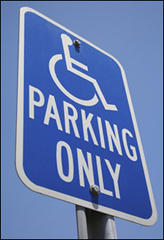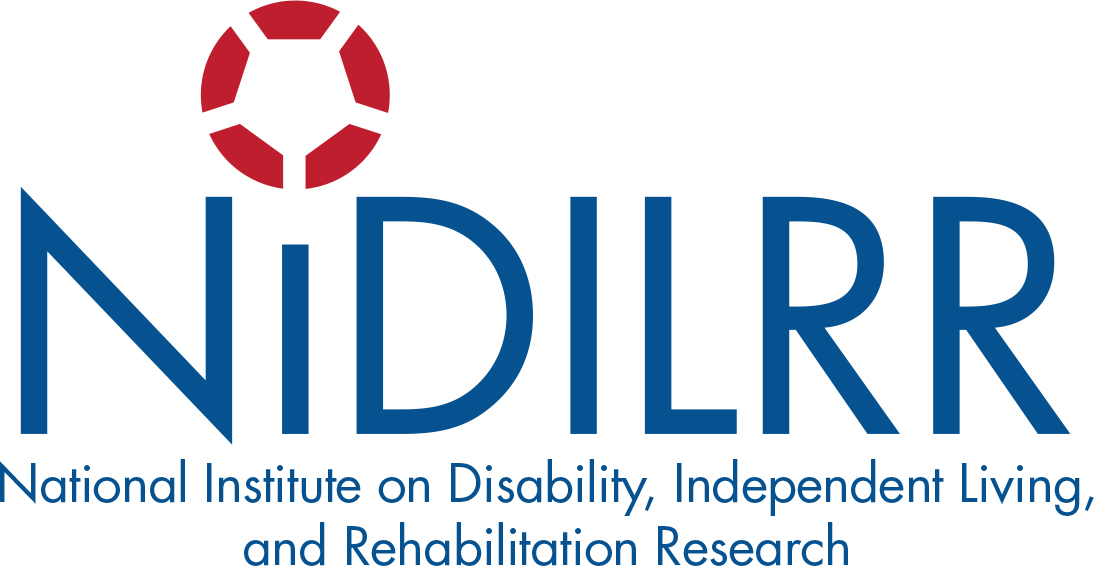Print-Friendly PDF | Large-Print PDF
 Obtaining a Parking Permit
Obtaining a Parking Permit
Eligibility Standards
A person may receive a parking permit if they have a disability that limits or impairs the ability to walk or involves acute sensitivity to light. The specific criteria are stated on the Disabled Parking Application for Individuals, which can be obtained from a vehicle licensing office or on the web:
Washington State Department of Licensing
Phone: 360-902-3770 | TTY: 711
http://www.dol.wa.gov
Applying for a Parking Permit
The applicant and a certifying medical professional must complete the application form. The applicant can submit the form by mail or deliver it to a vehicle licensing office. A receipt and disabled parking permit will be mailed as soon as the application is processed. An identification card should be received within 2-4 weeks. The medical professional must certify that the applicant meets at least one of the criteria on the state’s application.
Three Types of Parking Permits
Permanent Disability
Individuals may choose one of these options:
- A maximum of two blue placards which may be used by any vehicle transporting the individual with the privilege.
- One set of disabled parking license plates issued to the qualified individual, who must be one of the registered owners of the vehicle.
- One set of disabled parking license plates and one placard.
- One disabled parking tab and one blue placard.
The permanent parking privilege must be renewed every 5 years.
Temporary Parking
Individuals receive one red parking placard that is valid for up to 12 months. A new application is required to renew.
Organizational Vehicles
If your organization has vehicles that are used to transport any person with a disability, you may complete a Disabled Parking Application for Organizations. The organization will receive disabled placards or license plates which can be used by any vehicle transporting persons with disabilities.
Using Parking Privileges
Responsibilities
When exercising their parking privilege, individuals must have their identification card in their possession and make it available to law or parking enforcement officials when requested. Failure to comply may result in a citation.
Use of Windshield Placard
When parked in an accessible parking space, hang the placard from the rearview mirror post. If there is no post, place it on the dashboard. Make sure the placard is fully visible. Remove placard from mirror before moving the vehicle.
Reporting Abuse of Accessible Parking
Contact your local police to report individuals who are abusing accessible parking privileges or parking illegally in an accessible parking space.
Where to Park and Free Parking
A person who qualifies for a disabled parking privilege and has the required placard, plate or tab, can park in any designated accessible parking space.
Persons possessing a disabled parking privilege may park free of charge for unlimited periods of time in regular on-street parking spaces, at parking meters, or in spaces designated for persons with disabilities. Local jurisdictions may impose and post time restrictions of no less than 4 hours for the use of standard parking meters or on-street parking spaces designated for persons with disabilities. Parking is not permitted in areas where stopping, parking, or standing of all vehicles is prohibited or reserved for special types of vehicles (fire lanes, loading zones, bus lanes). Off-street parking facilities that charge for parking may charge the same fee to vehicles with a disabled parking permit.
Penalties for Unauthorized Use
It is a traffic infraction with a fine of $450 for any unauthorized person to obtain an identifying license plate, placard, or identification card in any manner not established by law.
Per RCW 46.19.050, it is a parking infraction, with a fine of $450 for a person to:
- Use the placard, identifying license plates, or identification card if they are not authorized.
- Exercise the parking privilege when the vehicle is not transporting the person to whom the privilege is issued.
- Exercise the parking privilege without an identifying license plate or placard.
- Block the access aisle located next to an accessible parking space.
Providing Accessible Parking
Persons who are limited in their ability to walk long distances may require features not available in standard parking spaces. For example, access aisles adjacent to the accessible parking space allow additional room for those using wheelchairs or other mobility aids to exit and enter their vehicles. Accessible parking spaces must satisfy requirements established by state law and the Americans with Disabilities Act.
An accessible parking space must:
- be located on the shortest accessible route of travel to an accessible building entrance
- be located on a firm, level surface
- provide level or ramped access to the walkway
- have a sign displaying the International Symbol of Accessibility mounted at a height of at least 5 feet from ground surface to bottom of sign in full view of the driver
Dimensions for Accessible Parking Spaces
Standard Vehicle Accessible Parking Space
8 Feet Minimum Space + 5 Feet Accessible Aisle
Van Accessible Parking Spaces
8 Feet Minimum Space + 8 Feet Access Aisle OR 11 Feet Minimum Space + 5 Feet Minimum Access Aisle
Maintenance of Accessible Parking Spaces
Individuals who own or control property must erect and maintain signs that designate the required accessible parking spaces. These parking spaces cannot be blocked or made inaccessible.
Number of Accessible Parking Spaces
|
Total Spaces in Lot |
Min. # Accessible Spaces |
||
|
Standard |
Van |
Total |
|
|
1 through 25 |
0 |
1 |
1 |
|
26 through 50 |
1 |
1 |
2 |
|
51 through 75 |
2 |
1 |
3 |
|
76 through 100 |
3 |
1 |
4 |
|
101 through 150 |
4 |
1 |
5 |
|
151 through 200 |
5 |
1 |
6 |
|
201 through 300 |
5 |
2 |
7 |
Note: One out of every six accessible spaces shall be designated with a sign as “Van Accessible” and be designed as shown above. If only one accessible space is required, it must be van accessible.
 The Northwest ADA Center is a member of the ADA National Network. This fact sheet was developed under grant from the Administration for Community Living (ACL), NIDILRR grant #90DP0016-02-00. However, the contents do not necessarily represent the policy of the ACL, and you should not assume endorsement by the federal government.
The Northwest ADA Center is a member of the ADA National Network. This fact sheet was developed under grant from the Administration for Community Living (ACL), NIDILRR grant #90DP0016-02-00. However, the contents do not necessarily represent the policy of the ACL, and you should not assume endorsement by the federal government.
